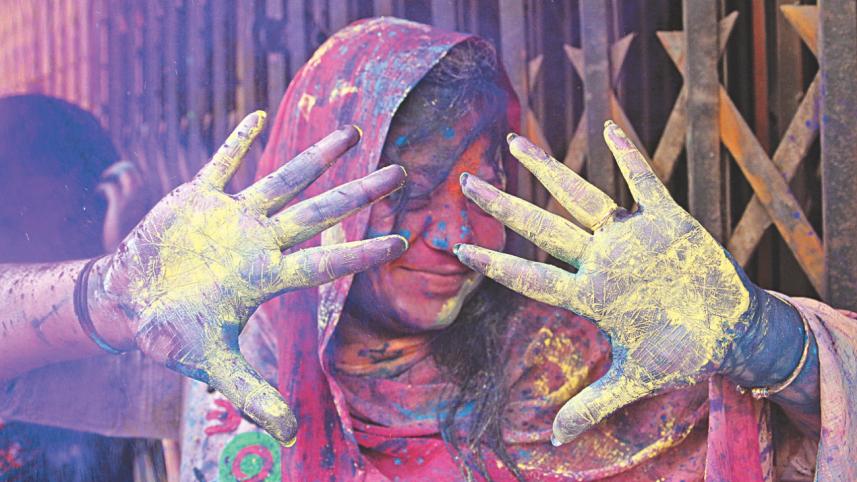Not for the Faint of Heart

After it was over I asked Mishal, my nephew, what he thought. "Not for the faint of heart," he replied.
The three of us – Mishal, his friend Ashik and myself – had gone to Shankhari Bazar to photograph the Dol Jatra (Holi) festival. This annual Hindu festival is celebrated in spring in many parts of the world. Although it has its roots in Hindu mythology, today its specialty is the frolic with colours.
We got our first hint of imminent excitement at the entrance to Tanti Bazar: the normally open alley was gated shut, only pedestrians allowed through a narrow opening. A reception committee of several youths armed with different forms of colours – paste, powders and water guns – greeted us joyously. Showing my camera, I got away with a light smear of orange on my forehead.
As we walked down the alley, the thumping music grew louder. Children ran willy-nilly spraying dye from their water guns. We reached the source of the music where a phalanx of one or two hundred people, faces coloured, gyrated to the pulsing dance music. Excitement was palpable in the air.
Having come here before, I was prepared. I had wrapped my camera in plastic, worn old clothes and smeared oil over exposed body parts. But I was jumpy and nervous.
The main reason was the camera. To take decent pictures, I would have to take it out of its plastic protection. That's when a spray of red from a water-gun, a bucketful of blue dumped from an overhead balcony or a frontal attack with powder or paste dye could destroy the camera.
By entering those gates we had implicitly agreed to play. We were fair game.
So far the playing had been relatively dry. Now we slowly made our way to Shankhari Bazar, the heart of the action. Reaching there, we found the wet party.
Most houses on either side of the narrow road have balconies. These were the platforms for the mischief makers who filled bucket after bucket of water, sometimes clean, sometimes mixed with dye, and dumped them on the revellers below.
Old people, sporting symbolic dashes of red or yellow on their faces, stood by doorways and watched with mixed emotions: a bit of longing to be young again, a bit of disdain for youth's follies. A woman in a sari emerged from her home to walk to a neighbour's, her face and clothes clean. Within seconds someone had dabbed a spot red on her cheek. She shook free, her face holding a smile, and kept walking. Then two or three young women and men accosted her. One part of her face managed to remain clear while the other half received a layer of deep purple. Then the other half went. Smiling calmly she surrendered to the inevitable, emerging with a darkened face.
Towards the front-end of Shankhari Bazar the crowds became thicker and increasingly rowdy. Those wanting to leave the alley pushed and shoved towards the exit. The side entrances had been closed off – one was gated shut and another was cordoned off. This, I thought, was a risky configuration that could easily lead to a deadly stampede.
Eventually we emerged from the melee and breathed the fresh, open air with a mix of relief and amazement at the wild party. It had been an exciting morning but as Mishal said it was not for the faint of heart.
facebook.com/tangents.ikabir.



 For all latest news, follow The Daily Star's Google News channel.
For all latest news, follow The Daily Star's Google News channel.
Comments